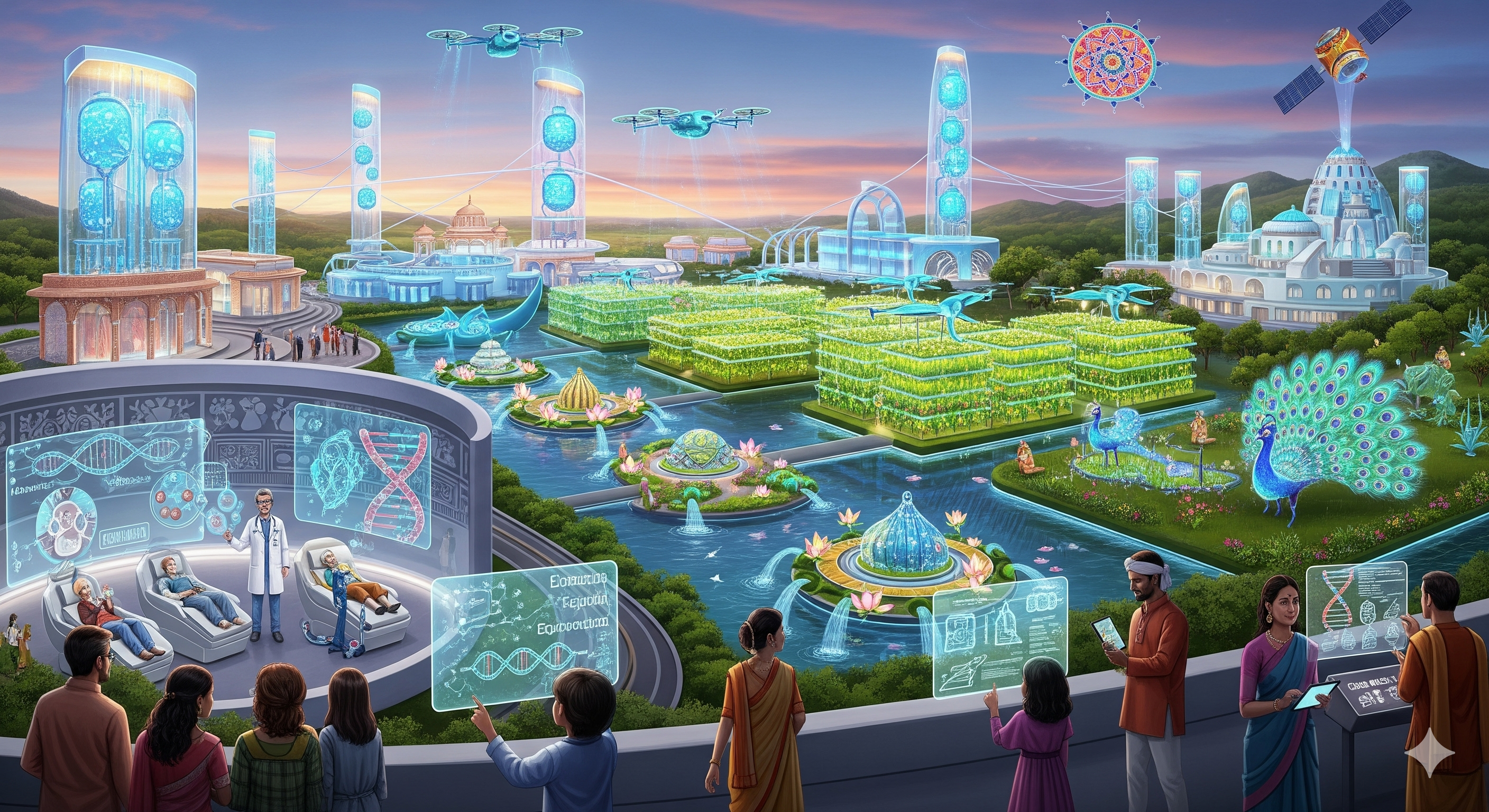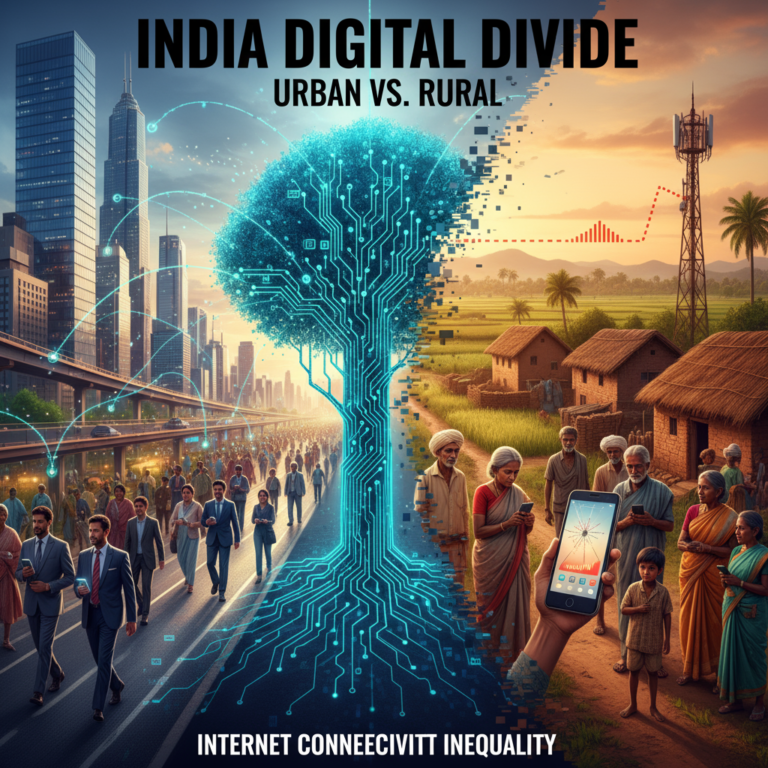Key Highlights
- CRISPR-Cas9 gene editing offers precision tools for targeted DNA modifications without introducing foreign DNA, making it faster and more cost-effective than traditional genetic engineering
- India’s bioeconomy has grown 16-fold from $10 billion in 2014 to $165.7 billion in 2024, with projections to reach $300 billion by 2030
- First FDA-approved CRISPR therapy Casgevy was approved in December 2023 for sickle cell disease and β-thalassemia, marking a revolutionary milestone in gene therapy
- India’s 2022 regulatory guidelines exempt SDN-1 and SDN-2 gene-edited plants from stringent GMO regulations, accelerating agricultural innovation
- The Genome India Project has successfully sequenced 10,000 genomes from 83 diverse communities, establishing India’s first comprehensive genetic reference database

Understanding the Genetic Revolution
The biotechnology landscape is experiencing an unprecedented transformation as gene editing and genetic engineering emerge as powerful tools reshaping medicine, agriculture, and environmental sustainability. While these terms are often used interchangeably, they represent distinct approaches with unique applications and implications.
Genetic engineering broadly encompasses the deliberate modification of an organism’s genetic material through inserting, deleting, or altering DNA sequences. This established technology frequently uses vectors like plasmids to introduce genes from other organisms, exemplified by successful applications like Bt cotton and Golden Rice.
In contrast, gene editing represents a more precise, targeted approach using tools like CRISPR-Cas9, TALENs, or ZFNs to make specific changes at predetermined DNA sites. This revolutionary technology allows corrections without introducing foreign DNA, making processes faster, cheaper, and more accurate.
Breakthrough Medical Applications
CRISPR’s Clinical Success Stories
The medical field has witnessed remarkable breakthroughs with CRISPR-Cas9 technology achieving its first regulatory approvals. Casgevy became the world’s first FDA-approved CRISPR therapy in December 2023 for treating sickle cell disease and transfusion-dependent β-thalassemia. aacrjournals
Clinical trials demonstrate exceptional results, with 92.31% of patients achieving transfusion independence and 84.62% experiencing ≥90% reduction in vaso-occlusive crises within 24 months. The therapy works by editing the BCL11A erythroid enhancer, increasing fetal hemoglobin production and preventing red blood cell sickling. aacrjournals

India’s Medical Gene Editing Progress
Indian researchers are making significant strides in CRISPR applications for healthcare. The Council of Scientific and Industrial Research–Institute of Genomics and Integrative Biology (CSIR-IGIB) is developing indigenous gene therapy for sickle cell disease, with promising laboratory results expected by January 2025.
The All India Institute of Medical Sciences (AIIMS) and other leading institutions are working on CRISPR-Cas9 gene editing to address the high prevalence of sickle cell disease among India’s tribal populations. This aligns with India’s mission to eradicate sickle cell disease by 2047, combining cutting-edge technology with national health objectives.
Agricultural Transformation Through Gene Editing
India’s Regulatory Breakthrough
India made a landmark regulatory decision in 2022 by releasing Guidelines for Safety Assessment of Genome Edited Plants. These guidelines exempt SDN-1 and SDN-2 gene-edited plants from restrictive GMO regulations, creating a fast-track pathway for agricultural innovation.
The Genetic Engineering Appraisal Committee (GEAC) no longer requires lengthy approval processes for gene-edited plants that don’t contain foreign DNA. This regulatory framework positions India among progressive countries embracing precision agriculture while maintaining biosafety standards.
Revolutionary Crop Developments
Indian scientists have developed impressive gene-edited agricultural innovations:
Drought and Salt-Tolerant Rice: Researchers at the Indian Agricultural Research Institute created gene-edited rice varieties expected to be commercially available by 2026.
Enhanced Mustard: Scientists at Delhi University’s Centre for Genetic Manipulation of Crop Plants used CRISPR-Cas9 to develop less pungent mustard with significantly higher glucosinolate content.
Biofortified Bananas: The National Agri-Food Biotechnology Institute successfully developed Vitamin A-fortified bananas to address nutritional deficiencies.

Livestock Gene Editing Milestone
India achieved a breakthrough in livestock biotechnology with the development of its first gene-edited sheep in Kashmir. Using CRISPR-Cas9 to knock out the myostatin gene, researchers created Kashmir Merino sheep with 30% more muscle mass while preserving wool quality.
This non-GMO approach demonstrates gene editing’s potential for enhancing meat production, improving animal welfare, and developing climate-resilient livestock without introducing foreign DNA.
Environmental and Sustainability Applications
Gene Drives for Vector Control
Gene drive technology represents a revolutionary approach to environmental sustainability, particularly in malaria control. Mathematical modeling studies demonstrate that gene drives could reduce mosquito populations by 71-98%, potentially averting at least 60% more clinical malaria cases when combined with existing interventions.
Researchers are developing resilient gene drives targeting the doublesex gene in Anopheles gambiae mosquitoes, with models predicting successful large-scale population suppression. This technology could complement traditional methods like insecticide-treated nets and vaccines for comprehensive disease control.
Engineered Solutions for Environmental Challenges
Gene editing applications extend beyond vector control to address broader environmental challenges:
Waste Treatment: Engineered microbes designed through genetic modification can decompose pollutants and process organic waste more efficiently.
Carbon Capture: Advanced biotechnology approaches using modified organisms could enhance carbon sequestration and support climate change mitigation efforts.
Biofuel Production: Companies like Sea6 Energy are transforming seaweed into biofuels and agricultural biostimulants, demonstrating biotechnology’s role in sustainable energy.
India’s Policy and Regulatory Landscape
Comprehensive Governance Framework
India has established a robust regulatory ecosystem for biotechnology through multiple competent authorities:
Genetic Engineering Appraisal Committee (GEAC): Primary regulatory body for environmental release of GMOs.
Institutional Biosafety Committee (IBSC): Monitors gene-edited plants under containment conditions.
Research Committee on Genetic Manipulation (RCGM): Assesses safety standards and potential risks.
State Biotechnology Coordination Committee (SBCC): Ensures state-level monitoring and compliance.
National Biotechnology Initiatives
The BIO-E3 Policy (Biotechnology for Economy, Employment, and Environment) represents India’s comprehensive strategy for biotechnology advancement. Key components include:
Bio-AI Hubs: Integrating artificial intelligence with biomanufacturing for enhanced innovation.
National Biofoundry Network: Establishing biomanufacturing infrastructure across the country.
BioSaarthi Initiative: Global mentorship program connecting Indian biotech startups with international experts.

International Alignment
India’s regulatory approach aligns with global biosafety standards while maintaining national sovereignty. The country is a signatory to the Cartagena Protocol on Biosafety, ensuring international cooperation while developing indigenous capabilities.
Economic Impact and Market Dynamics
Bioeconomy Growth Trajectory
India’s bioeconomy has experienced explosive growth, increasing from $10 billion in 2014 to $165.7 billion in 2024—a remarkable 16-fold increase. The sector now contributes 4.25% to national GDP with a compound annual growth rate of 17.9%.
The biotech startup ecosystem has expanded dramatically from 50 startups a decade ago to over 10,075 today. Investment patterns show $1.9 billion invested across 465 deals between 2020-2024, with peak funding of $749 million in 2022.
Sectoral Distribution and Innovation Hubs
Biopharma and medical biotechnology dominate funding with 42% of total investments, while emerging sectors gain traction:
Sustainable Materials: 7% of investments
Agrifood Life Sciences: 10% of investments
Industrial Biotech: 10% of investments
Bio-services & Informatics: 31% of investments
Geographically, Bengaluru, Delhi-NCR, Mumbai, and Chennai attract 90% of total investment, though cities like Pune, Hyderabad, and Ahmedabad are emerging as promising biotech hubs.
Global Market Position
The global CRISPR gene editing market is projected to reach $16.47 billion by 2034, growing at a 14.77% CAGR. India is positioning itself as a significant player in this expansion, particularly in cost-effective solutions and population-specific applications.
Precision Medicine and Genomic Advances
Genome India Project Achievement
The Genome India Project represents a landmark achievement in precision medicine, successfully sequencing 10,000 genomes from 83 diverse ethnic communities. This comprehensive dataset, archived at the Indian Biological Data Centre, provides crucial insights into India’s genetic diversity.
The project discovered over 135 million genetic variations, including 7 million novel variants absent from global databases. These findings enable population-specific disease risk prediction, personalized drug responses, and precision medicine tailored to Indian genetics.
Clinical Applications and Market Growth
India’s precision medicine market is projected to reach $7.3 billion by 2028, driven by increasing awareness and technological advancement. The Indian genetic testing market reached ₹4,544.5 crore ($61 million) in 2022 with substantial growth projected.
Key applications include:
Oncology: Genetic testing for cancer predisposition and personalized treatment protocols.
Pharmacogenomics: Tailoring drug selection and dosing based on individual genetic profiles.
Rare Disease Diagnosis: Enhanced diagnostic capabilities for inherited genetic disorders.
Ethical Considerations and Societal Impact
Balancing Innovation with Responsibility
The rapid advancement of gene editing technologies raises important ethical questions regarding safety, equity, and societal impact. Concerns include potential biodiversity loss, biosecurity threats, and debates surrounding designer babies.
Benefits include enhanced food security, personalized medicine, and pharmaceutical innovations that could transform healthcare accessibility. However, equity concerns persist regarding intellectual property rights and treatment affordability.
Addressing Access and Affordability
The $2.2 million cost of Casgevy treatment highlights affordability challenges in developing countries. Indian researchers are working to develop cost-effective alternatives that could make gene therapies accessible to broader populations.
Government initiatives like the sickle cell disease eradication mission demonstrate commitment to equitable healthcare access, combining advanced technology with population health strategies.
Future Outlook and Emerging Trends
Technology Convergence
The future of biotechnology lies in convergence between gene editing, artificial intelligence, and digital health platforms. Bio-AI hubs are integrating machine learning with genetic research to accelerate drug discovery and precision medicine.
Prime editing and base editing technologies are advancing beyond CRISPR-Cas9, offering even greater precision for therapeutic applications. These innovations promise safer, more effective treatments with reduced off-target effects.
Global Collaboration and Competition
India is positioning itself as a global biotech leader through international partnerships and knowledge exchange. The IGI CRISPR training programs in India demonstrate collaborative efforts to build local capacity while maintaining global connections.
Strategic partnerships between Indian startups and international companies, such as NKure Therapeutics collaborating with CRISPR Therapeutics, showcase India’s growing role in global biotech innovation.
Key Challenges and Solutions
Technical and Regulatory Hurdles
Off-target effects remain a significant concern in gene editing applications, requiring continued research into enhanced specificity and safety protocols. Delivery challenges for in vivo gene editing necessitate innovative delivery systems and targeted approaches.
Regulatory harmonization between different biotechnology applications requires clear guidelines distinguishing gene editing from genetic modification. Public awareness and scientific communication are essential for informed policy decisions.
Market and Investment Considerations
While biotech funding peaked in 2022, investment patterns show increased selectivity toward late-stage companies with proven technologies. Sustained capital flow is essential for supporting early-stage innovations and translational research.
Infrastructure development, including biomanufacturing facilities and specialized laboratories, requires continued government support and private investment.
Conclusion: Embracing Biotechnology’s Promise
India stands at the forefront of a biotechnology revolution that promises to transform healthcare, agriculture, and environmental sustainability. The distinction between gene editing and genetic engineering represents more than technical differences—it reflects evolving capabilities to address humanity’s greatest challenges with unprecedented precision.
CRISPR technology’s first clinical successes, India’s progressive regulatory framework, and the explosive growth of the bioeconomy demonstrate the sector’s transformative potential. The Genome India Project’s achievements and emerging agricultural innovations position the country as a global leader in biotechnology applications.
Success requires continued collaboration between researchers, policymakers, and industry stakeholders to ensure responsible innovation that benefits all sections of society. By balancing scientific advancement with ethical considerations and equitable access, India can lead the world in harnessing biotechnology for sustainable development and improved human welfare.
📝 Mains Questions
- Compare gene editing and genetic engineering in terms of ethical, scientific, and socio-economic implications.
- How can India balance innovation in biotechnology with biosafety regulations?









+ There are no comments
Add yours